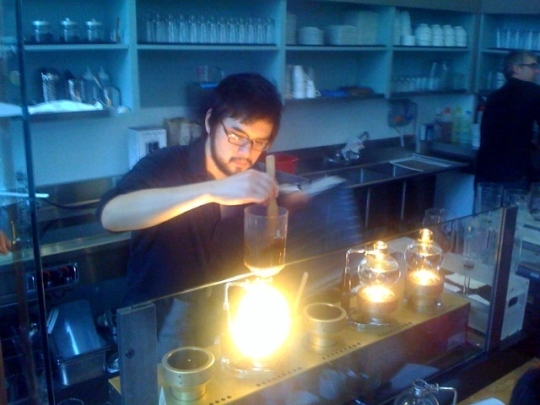In “Mad Flavor,” I describe exceptional culinary experiences from small artisan producers. Mad Flavor is currently reporting from the San Francisco Bay Area.
Now these guys obsess over coffee.
I say that with affection. For years, I home-roasted my own green beans. I once owned a vacuum pot, and used it lovingly until it shattered. A famous Roman espresso bar once moved me to tears of joy.
But I’ve never dropped 20 grand on a fancy brewing contraption. Oakland’s Blue Bottle Co. did recently. At Blue Bottle’s new downtown San Francisco café, customers snake around the corner and down the street for a chance to see the new “siphon bar” in action.

Coffee as spectacle.
Photo: Bonnie Powell, Ethicurean.
A halogen-powered heating element sends water vapor up a tube into a chamber, where it meets a precisely weighed and ground ration of coffee. A skilled worker stirs the coffee/water mixture with a bamboo paddle, and then it sinks back into he lower chamber, mysteriously and perfectly filtered.
The results are as dramatic as the spectacle: a clean, pure expression of Blue Bottle’s carefully sourced, delicately roasted beans. The Ethiopian Sidamo I tried delivered a beautiful, nutty aroma and a fruity flavor that lingered on the palate like a good wine.
Does Blue Bottle’s “siphon bar” represent unchecked decadence — or a way forward for socially and ecologically responsible coffee drinking?
To be sure, we coffee drinkers have a tough road to hoe to claim social and ecological responsibility. Like all the tropical commodities — sugar, tea, bananas, etc. — coffee bears (or should bear) a heavy historical stigma. An account by University of California-Santa Cruz historian Chris Brooks tells the sordid tale.
In the 19th century, when coffee was establishing itself as a U.S. morning ritual, Brazil’s Portuguese rulers were busy razing vast swaths of pristine Amazon rainforest to plant the lucrative crop. They used — literally consumed — slave labor. In Ceylon — present-day Sri Lanka — the British attempted a similar feat using indentured Indian labor. The soil proved unsuitable to maintain coffee production over the long haul, but the colonial rulers didn’t figure that out until they had leveled the rainforest that covered the Kandyan Highlands. Natural sponges for atmospheric carbon, those vanished rainforests would come in handy today.
Coffee remains a troublesome beverage; it deeply taxes resources in places where it’s grown. “A single coffee bush can produce around a pound of roasted coffee each year when mature,” writes coffee expert Gregory Dicum in the Spring 2003 Gastronomica. “Each cup of coffee still represents a plot of land a little bigger than [a standard] magazine.”
And as I wrote in my recent coffee tasting, a few giant corporations — not the globe’s millions of coffee growers and field workers — benefit from the revered brew’s popularity. No “responsible consumer” can enjoy coffee without accounting for these stark facts.
It was in that context, I think, that a reader responded to a recent NYT piece on Blue Bottle’s new contraption like this:
For most of last year I lived on a small coffee plantation in rural Guatemala called Comunidad Nueva Alianza. Since gaining control of the land three years ago, the workers there are now able to pay themselves $3.20 a day. I often send them news articles related to coffee and its place in the global economy. To do so in this case seems obscene.
I see where the writer is coming from, but I disagree. The “siphon bar” will not inspire people to mindlessly quaff coffee in search of a buzz. It invites people to stop and watch and watch coffee being brewed — by a skilled worker, not a button-pushing clerk.
And the coffee itself forces you to think and taste.
Where Blue Bottle misses an opportunity is by not providing its rapt audience with information about the farms on which it’s excellent coffee is grown.


